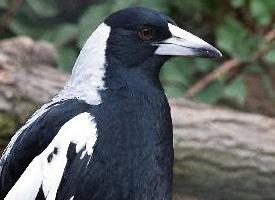
Descrierea animalului
The Pied Butcherbird (Cracticus nigrogularis) is a captivating species belonging to the Artamidae family, which also includes other butcherbirds, currawongs, and the Australian Magpie. This bird is primarily found across Australia, displaying a marked preference for a variety of habitats ranging from arid shrublands to urban areas, though it is less commonly seen in dense forests and arid deserts. The species exhibits a distinctive appearance and behavior that make it a subject of interest among birdwatchers and nature enthusiasts.Physically, the Pied Butcherbird possesses a striking black and white plumage that immediately catches the eye. The adult bird's upper parts are mostly black, with a distinctive white patch on the back of the neck and a partly white tail. The underparts are predominantly white, creating a sharp contrast with the black throat patch from which the species derives its name 'nigrogularis', meaning 'black-throated'. Juveniles display a more mottled brown and white appearance, gradually acquiring the adult plumage as they mature. This bird is medium-sized, measuring about 35 cm in length, and features a robust body, a strong, hooked beak designed for its carnivorous diet, and long legs.
One of the most remarkable aspects of the Pied Butcherbird is its song. Known for its melodious and complex vocalizations, the bird is considered one of Australia's finest songbirds. Its repertoire is vast and varied, consisting of beautiful, flute-like melodies that can be heard at dawn and dusk. These songs are not only a means of communication but also play a role in establishing territories and attracting mates.
The diet of the Pied Butcherbird is carnivorous, consisting mainly of insects, small vertebrates, and occasionally, other small birds. Its hunting technique is fascinating; the bird often perches silently, watching for movement before swooping down on its prey with precision. Additionally, it has been known to store food in the forks of branches or impaled on objects such as thorns or barbed wire, a behavior that has earned the butcherbird its name.
Socially, the Pied Butcherbird lives in family groups consisting of a breeding pair and their offspring from previous seasons. These groups maintain and defend territories throughout the year. Their social structure is complex, involving cooperative breeding practices where older offspring assist in raising the young.
Breeding season for the Pied Butcherbird varies depending on the region but generally occurs during the warmer months. The nest, constructed by the female, is a robust structure made of twigs and lined with softer materials. Typically, two to five eggs are laid, which are then incubated by the female while being defended and fed by the male and sometimes by older offspring.
In summary, the Pied Butcherbird is a fascinating species notable for its striking appearance, complex social behaviors, and particularly, its enchanting song. Its adaptability to various environments, including urban areas, has allowed it to thrive in diverse habitats across Australia. This bird not only contributes to the ecological balance by controlling insect populations but also enriches the auditory landscape with its melodious presence, making it a cherished member of the Australian avifauna.
Animale similare
Fotografii noi cu animale
Top 10 animale
- Diana monkey (Cercopithecus diana)
- Dolphin gull (Leucophaeus scoresbii)
- Galápagos tortoise (Geochelone nigra complex)
- Moustached guenon (Cercopithecus cephus)
- Japanese spider crab (Macrocheira kaempferi)
- Colossal squid (Mesonychoteuthis hamiltoni)
- Fox tapeworm (Echinococcus multilocularis)
- Stone loach (Barbatula barbatula)
- Japanese macaque (Macaca fuscata)
- Barbary macaque (Macaca sylvanus)
